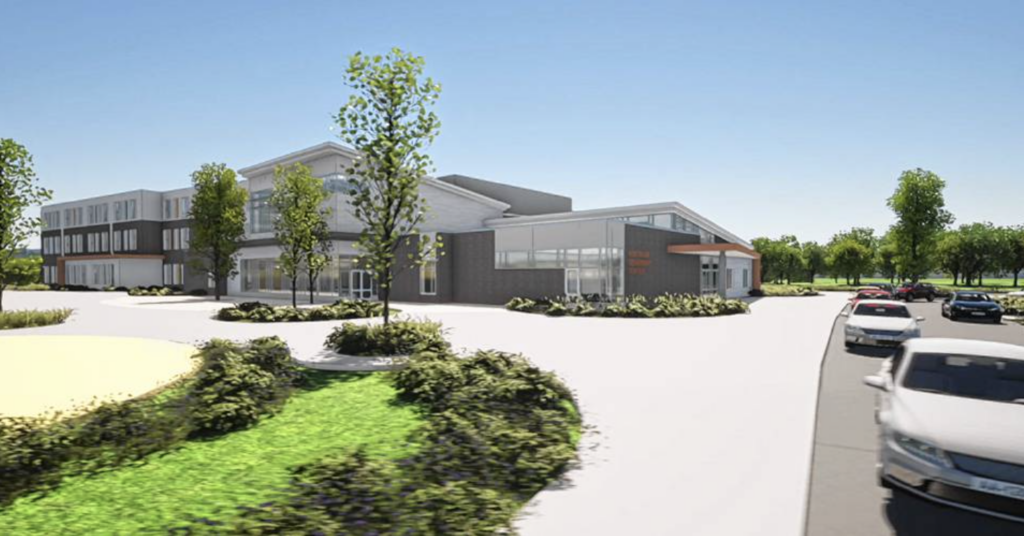Opinion: Four Reasons To Vote For The New Elementary School

Architect's rendering of the proposed new elementary school at Fort River. Photo: DiNisco Design
by Rudy Perkins and Darcy DuMont
This column appeared previously in the Amherst Bulletin.
The Amherst Zero Energy Town Buildings Bylaw was adopted “to help counter and prevent the effects of global climate change.” That bylaw requires Amherst’s major new municipal buildings to be “net zero” — able to produce as much renewable energy annually as the building is likely to use.
Amherst’s Climate Action Adaptation and Resilience Plan noted that existing buildings account for as much as 40% of U.S. greenhouse gas emissions and 74% of Amherst’s. Climate-protective buildings are essential to defusing the climate crisis.
So, the fact the new elementary school at Fort River will be Amherst’s first municipal net-zero building is high on our reasons to vote yes for the new school. That’s also why local climate groups including the Mothers Out Front Zero Energy Municipal Building Task Force, the Amherst Climate Justice Alliance (comprising twelve local groups), and the Energy and Climate Action Committee are endorsing the new Fort River school.
The climate-protecting investment greatly energizes our yes vote for the new school. But on top of that compelling reason, the Fort River project will cost-effectively give Amherst four important new overlapping community investments for our future.
First, A Great New School
The new school will have an improved educational layout, with acoustically separated classrooms clustered around shareable project areas, better integration of special education resources, improved natural daylighting that boosts student educational performance, outdoor learning venues, and 21st-century connectivity and technology.
The school is designed to further improve student and staff health, safety, security and accessibility. For example, the new school will be fully protected by a sprinkler system and have a code-required Ansul kitchen fire suppression system. It will be better ventilated and have radically upgraded humidity, moisture and condensation control — key to healthy buildings.
It will have an administrative office better positioned to see who is entering the school, with security transaction windows to the main entrance vestibule and the main classroom wing able to be locked down separately in an emergency. Overdue design elements will improve its accessibility for students, staff and community members alike.
Second, A Crucial Step Forward For Amherst On Climate Protection
The new school will give us an exemplary high-efficiency, all-electric, solar-powered, fossil-fuel-free building, heated and cooled with a ground source heat pump (aka geothermal) system, and it will allow us to demolish the existing archaic, greenhouse gas-emitting Fort River building.
It will give us a powerful new 649 kW (estimated) rooftop and parking lot solar array without impact on forests or farmland. Generations of Amherst kids will soon grow up learning firsthand that energy-efficient, solar-powered buildings are more comfortable, healthier, cheaper to operate, and already feasible today to help protect their climate future tomorrow.
An anticipated utility grant of $1.6 million, and expected Inflation Reduction Act subsidies of up to 30% of clean energy equipment costs, could pay most of the additional upfront investment for the solar and geothermal systems. Resulting yearly energy cost savings, estimated at up to a quarter-million dollars, would help pay back the rest.
As much as three-quarters of a million dollars more may also be saved yearly in reduced maintenance and other cost savings from the consolidation of the two schools and their duplicative facilities.
Third, New Community Resources And A Climate Resilience Asset
The school will include after-school community resources of its new gym and cafetorium with a supporting kitchen and stage. When combined with the geothermal heating and cooling system, and the plan to wire key parts of the new building to a back-up generator, the cafetorium can do double duty for community climate resilience, offering temporary heated/cooled shelter for hundreds of residents in the event of power outages and weather emergencies, at virtually no additional construction cost.
Fourth, Upgraded Community Recreational Fields Adjoining The School
The current Fort River playing fields are used by hundreds of young people and adults in the community, but are in poor condition, having inadequate drainage and grading. By piggybacking recently approved CPA recreational funds for Fort River field renovation with site improvement work for the school, we’ll synergize playing field funding for both school and community uses. After-school sports programs and Fort River elementary students will all benefit.
Yes, we’ll have to invest more in annual property taxes to make this happen. But with the state MSBA likely funding about 40% of project costs, current subsidies for energy improvements, and annual energy and school consolidation savings for the operating budget, this is an investment opportunity we shouldn’t miss. (We do urge the Town Council to support efforts to reduce the impact on taxpayers.)
Please vote yes for the new Fort River school.
Look here for endnotes and references for this column.
Darcy DuMont is a founding member of Zero Waste Amherst, Local Energy Advocates of Western MA, and the Amherst Climate Justice Alliance. As a Town Councilor, she sponsored the legislation creating the Amherst Energy and Climate Action Committee.
Rudy Perkins is a former staff attorney and project manager for an area affordable housing developer, where his work included managing development of energy-efficient apartment buildings with rooftop solar. He served as a member of Amherst’s Fort River Building Feasibility Study Committee and helped renegotiate Amherst’s Zero Energy Town Buildings Bylaw.
Both live in Amherst.

Nice photo, but too many cars — and something is missing: where are the bicycles and bike racks (and the bus stops :-))?